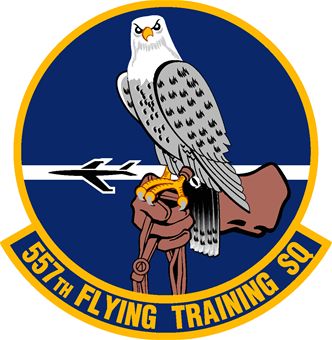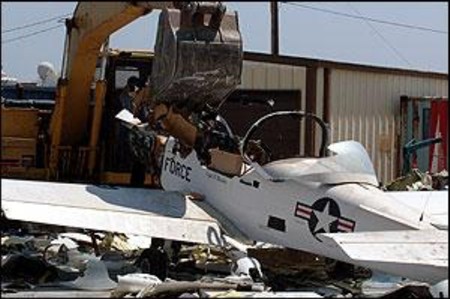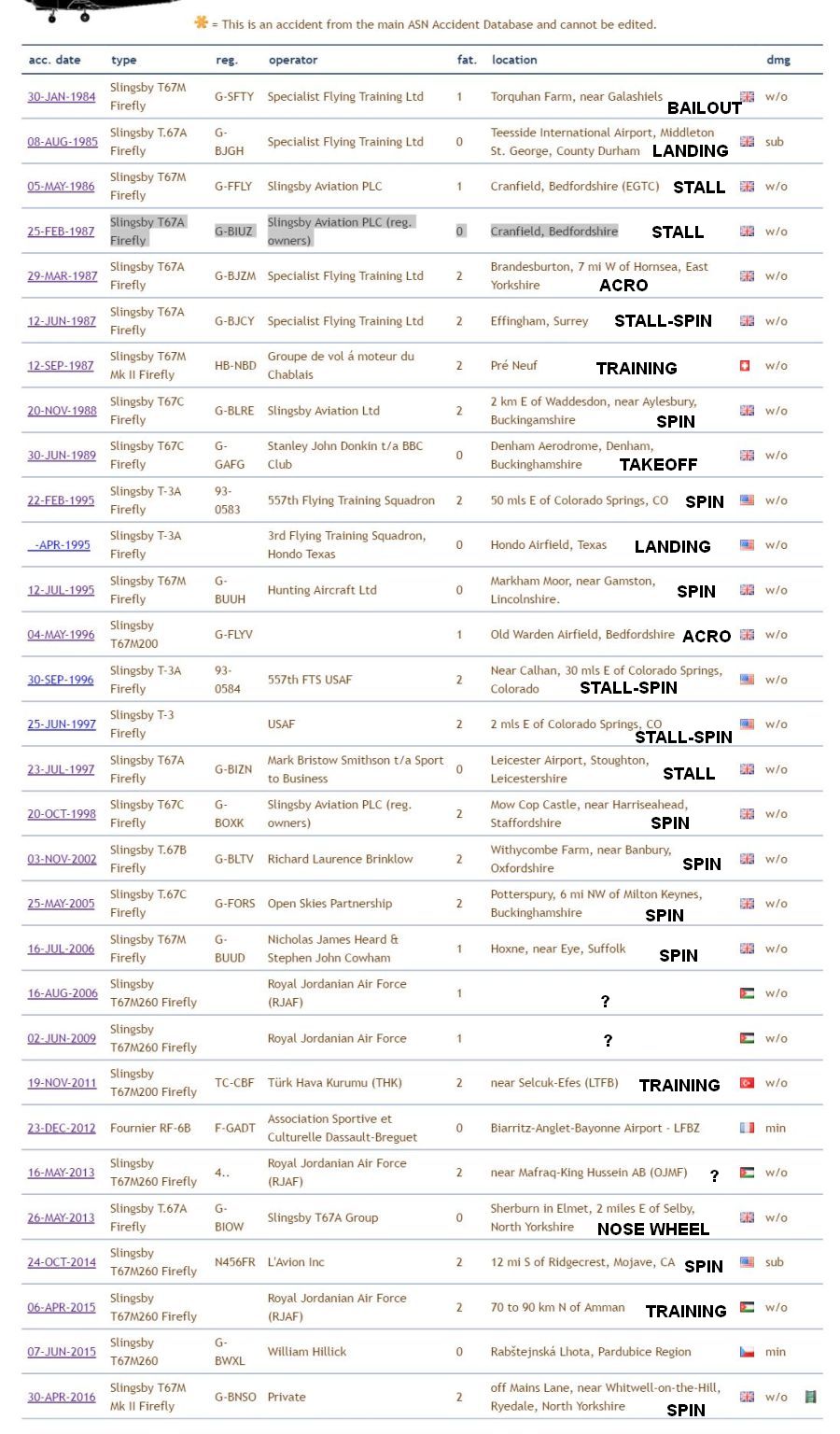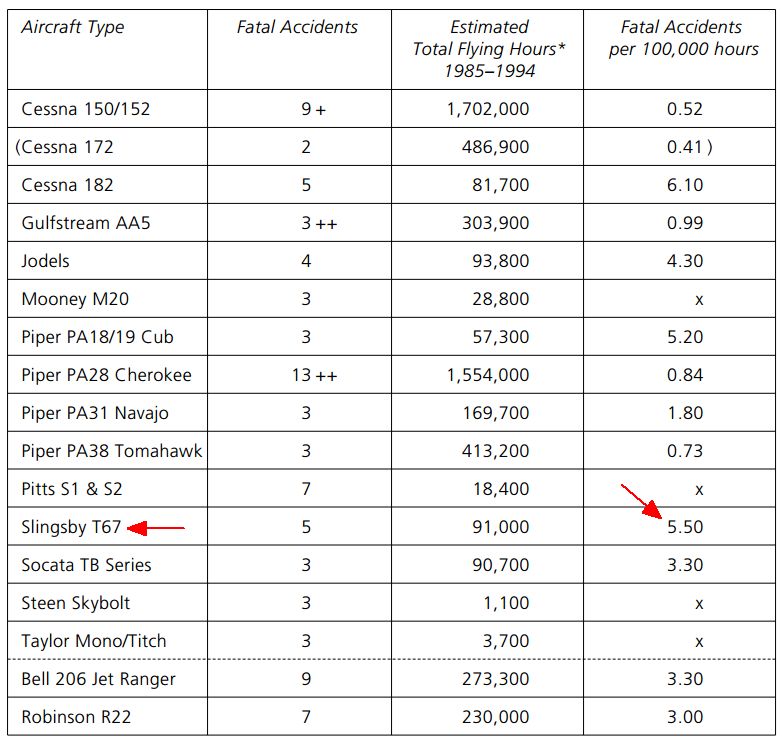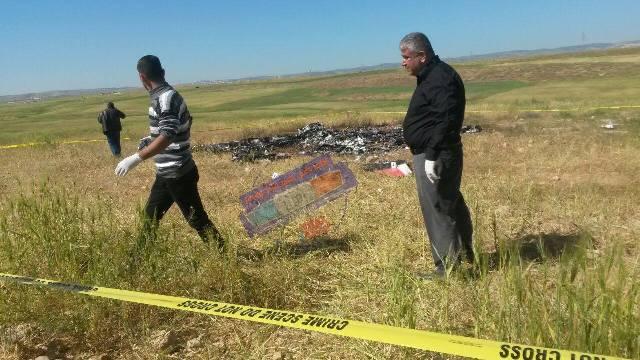T-3A (original) (raw)
The T-3 and Me
By Major Rob Robinette
In my 21 years as a US Army and Air Force pilot my most dangerous assignment came as an instructor pilot at the United States Air Force Academy flying the Slingsby T-3A Firefly trainer.
The T-3A "Plastic Coffin" was a cool little fully aerobatic plane with a propensity for killing pilots. It killed a good friend and flight-mate of mine, Captain Dan "Fish" Fischer in February 1995. The T-3A went on to kill a total of three Air Force Instructor Pilots and three cadet student pilots in less than three years of service at the Academy. A fourth aircraft from the 3rd Flying Training Squadron in Hondo, Texas was also destroyed in a landing accident during that period.
When you combine these six lost souls and four lost aircraft with the Slingsby T67/T-3A Firefly's dismal safety record of 36 fatal accidents killing 48 occupants (and counting) you begin to understand just how dangerous this aircraft is. In fact the T-3A was so dangerous the Air Force completely destroyed its entire fleet instead of selling them or giving them to Air Force flying clubs like it did with the T3A's predecessor, the T-41.
I flew the T-41C and T-41D Mescalero at the Academy from August '92 to September '94. I transitioned into the T-3 in late 1994 during the plane's phase in and I flew it until September '96 when I left the Academy.I was the 557FTS Flight Safety Officer during the first fatal T-3 accident in Feb '95 and I served on that first flight safety investigation board.
US Air Force T-3A Firefly
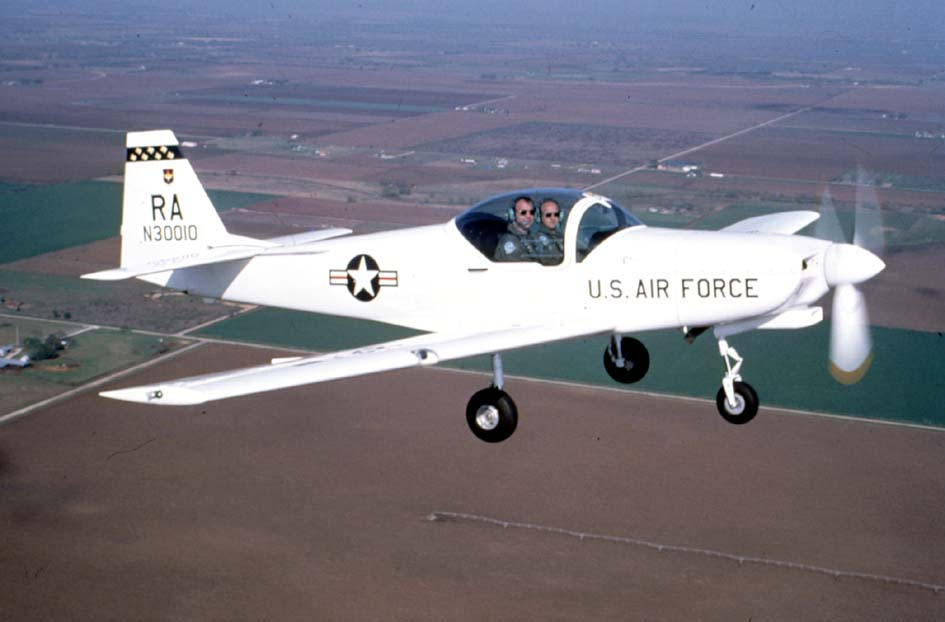
Replacing the T-41C Mescalero
The T-41C was a high powered version of the Cessna 172 similar to the 172XP. Cessna called it the 172F. Its larger AEIO-360 four cylinder fuel injected 180 horsepower engine was needed to handle the very high density altitudes of the Academy airfield. The T-41 served the Academy for over 25 years without a single fatality. The T-41 was very safe and easy to fly and was not rated for aerobatics but as an initial trainer it was perfect. The mission of the training squadrons at the Academy and Hondo Texas was to screen out individuals who could not fly well enough to complete Air Force pilot training. Doing this in inexpensive to fly propeller aircraft was a cost savings measure. The course also served as an introduction to military powered flight for the Academy cadets so they could make a more informed decision about becoming an Air Force pilot versus becoming a non-flying support officer.
US Air Force T-41C Mescalero

The US Air Force's T-3A was derived from the Slingsby Aviation T67M200 Firefly. Slingsby was an England based company which began building small aircraft in the 1970's. The Air Force liked the 200 horsepower T67M200 when they tested it in August 1990 but felt it needed more power to handle the Academy airfield's high altitude. Slingsby went to work to satisfy the Air Force and one year later in August 1991 the Air Force flew the big engined T67M260--yes,Slingsby built the big 6 cylinder version of the T67 in under a year. The T67M260/T-3A has several significant differences from the T67M200 with the biggest differences being the use of the monstrous 6 cylinder AEIO-540, 540 cubic inch 260 horsepower engine and the addition of air conditioning. The big engined aircraft was called the T67M260 by Slingsby and the T-3A by the Air Force.
The Air Force considered the new aircraft an "off the shelf" acquisition but the 1998 Enhanced Flying Screening Broad Area Review report found:
This accelerated fielding schedule often limits test opportunities which may be appropriate in some cases.When an item is procured without modification and used in the same environment for which designed, testing can often be streamlined or waived. Such was not the case for the T- 3A(larger engine, slow taxi requirements, constant use of fuel pump, continuous high RPM operation, and high-altitude operations at USAF Academy); but, testing was still intentionally abbreviated. Acquisition decision makers believed that since the Firefly was a proven trainer used in other countries, such as the UK and Canada, “missionized” and operational environment testing requirements could be minimized or waived.
"Acquisition decision makers believed that since the Firefly was a proven trainer used in other countries. . ."
No, no one had ever flown the new big engined T67M260 in an operational environment.
557FTS Patch
The T-3A Firefly was acquired by the Air Force because someone pulled a theory out of their butt:
If we make flight screening students do spins and aerobatics we'll wash out more students and save money.
Brilliant! Not one freakin' T-3 student was washed out for aerobatics or spins. They washed out for the same reason as in the T-41--the inability to land the plane well enough to solo. The T-3 training program was ironically called the Enhanced Flight Screening Program but the only thing enhanced was the danger. I liken the T-3 to the Pitts Special--the aircraft have very similar accident and fatality rates. Can you imagine trying to teach a new, zero hour student pilot how to fly in a Pitts Special? That's what the pilots of the 557FTS were tasked with. We did our best but not without grave loss.
We initially flew aerobatics and spins in the aircraft without wearing parachutes because the military is exempt from FAA regulations that require parachutes when conducting aerobatics and spins. The cost of the two parachute shops (at Hondo, Texas and at the Academy) and weight penalty were given as the reasons the Air Force made this decision.
The T-3 was a relatively unforgiving aircraft that would snap roll (flick) with very little rudder displacement accompanied with ANY stall buffet. This and the very nose low/high spin rate spin mode are the primary reasons the Slingsby T67M/T-3A has such a terrible safety record--over 14% of the T-67 fleet has been destroyed in fatal accidents.
The T-3's typical spin entry was a snap roll with the aircraft going completely inverted during the first turn which was very disorienting for new pilots. The aircraft would not recover from a spin if you released the flight controls--it would actually wrap up and spin faster with the nose even lower than normal. The T-3 did spin very nose low--so low you had to look way up to see the horizon. It also spun very fast. It was nothing like the T-37 spin, nothing at all. The T-3 spun so fast that at spin recovery your eyes would go into nystagmus (your eyeballs bounce back and forth).
The high altitude of Academy spin training--we entered all spins between 11,500 to 12,000 feet above mean sea level--did affect the way the aircraft spun and recovered. The thinner the air the less the flight control surfaces have to work with during a spin recovery. I believe this is one of the reasons all the spin accidents occurred at the Academy.
US Air Force Academy
Academy proper and ball fields at upper left, Academy Airfield at bottom right at 6,572 feet of elevation. The two aerobatic training areas were about a 15 minute flight to the northeast of the Academy and east of Colorado Springs.
Vapor Lock
In March 94 the entire T-3A fleet was located at Hondo, Texas when a series of vapor lock engine stoppages caused the Air Force to ground the T-3A fleet for 50 days, so vapor lock was not just a problem at the Academy.
The Academy's high density altitude had a dramatic effect on vapor lock induced engine stoppages both on the ground and in the air. The airfield is at 6,572 feet above mean sea level and summertime density altitudes sometimes exceeded 10,000 feet. I believe the Academy's operating altitude was one reason Hondo, Texas lost only one T-3 while the Academy lost three. These high altitudes coupled with the very tight cowling around the big Lycoming IO-540 engine plus the heat generated by the air conditioning system caused massive vapor lock problems. A vapor lock occurs when low pressure fuel is warmed to the boiling point and fuel vapor causes the fuel pump to lose its prime. The engine simply would not start for a second or third sortie if the Academy airfield temperature was above 70 degrees due to fuel line vapor lock.
Our maintainers found that using a bicycle pump to pressurize the fuel tank vent would usually get the fuel moving enough to get the plane started. In a pinch you could even put your lips on the fuel vent tube and blow to get a T-3 started. The T-3's fuel system pump wasn't located in the fuel tank like most planes, it was inside the cowling under the engine so it would actually place the fuel between the pump and fuel tank at a lower vacuum pressure for even more vapor lock fun--that's Jaguar quality British engineering right there. We had over 100 engine stoppages during taxi at the Academy. There were also 10 reported in-flight engine stoppages and only one was due to mechanical engine failure. In contrast the T-41 had no problem with vapor lock at the Academy airfield with it's high wing fuel tanks and gravity fed fuel system.
Brake Failures
The T-3A's parking brake pressure lock system was designed in a way that allowed air bubbles to be sucked into the master cylinder when you released the parking brake lock. We had hundreds of complete brake losses, many of them after the pre-takeoff run-up when the parking brake was released. Some of these failures resulted in runway incursions because the plane couldn't be stopped at the runway hold-short line. I had a full brake failure during taxi and departed the paved taxiway because I couldn't turn the aircraft with differential brakes. The brake pedals would go full down with no braking action at all. If you pumped the brakes they would usually come right back. We stopped soloing students because of the brake failure issue. It's funny, but our student wash-out rate fell dramatically once our instructors were no longer forced to make the solo--no solo choice for weak students.
Spin Recovery Failures
While I was at T-3 transition training at Hondo, sometime around October '94,a Hondo civilian instructor and student had a close call during a student ride. They pulled out of a planned practice spin at very low altitude. The instructor was really shook up. He said he tried several spin recoveries before one finally worked. They gave him more spin training and sent him back to the line. I mention the instructor is a civilian because all three of the instructor pilots killed in the T-3 were military C-141 Starlifter pilots. The C-141 is a large, four jet engine cargo plane but all three pilots had successfully completed AF Pilot Training in the T-37 twin jet and T-38 supersonic trainers. They completed spin training in the T-37 and flew aerobatics in the T-37 and T-38. There was much made about the fact that no civilian instructors were involved in the fatal mishaps but the Academy had only military instructors--all the civilian instructors were at Hondo, Texas (elevation 930') doing spins in nice thick air. But a civilian instructor was at the controls when a T-3 was destroyed in a landing accident at the Hondo airfield.
A couple of weeks before the first fatal accident in January '95, an instructor and student at the Academy also had a close call from a very low altitude spin recovery. The aircraft entered the planned spin at about 6,000 feet above ground level. The instructor made several unsuccessful spin recovery attempts before finally pulling out just a few hundred feet above the ground. The instructor was white as a ghost when she came into the squadron building. They gave her more spin training and sent her back to the line. T-3 pilots and students were not wearing parachutes at this time so bailing out was not an option.
Spin Recovery Procedure
A standard T-3 practice spin entry was done at idle throttle and full pro-spin rudder was held until recovery rudder was applied. The aircraft normally went inverted during the first turn of the spin. We entered spins at the academy at 11,500-12,000 MSL with ground level between 5,300 to 7,300 feet in the training areas. That gave a minimum of 4,200 feet from entry altitude to ground level.
Bold items below were normally spoken aloud by the pilot flying during the recovery.
Idle: Throttle to idle.
Neutral: Ailerons to neutral position--the rudders were intentionally NOT neutralized to allow the aircraft to stay in the spin so we could practice the full spin recovery. This procedure should have been changed to "Neutral: Rudder and Ailerons" after the first fatal accident but the safety investigation board declined to suggest this procedure change. The pilot and safety officer members of the team said that if we did the spin recovery that way the aircraft would pop out of the spin during the first turn and I replied, "Then you win. That is the purpose of the spin recovery." In the1998 Broad Area Review of the Enhanced Flight Screening Program report the change to neutral rudders during the spin recovery was also recommended.
Aft: Elevator (stick) full aft and held against the stop.
Spinning Left (or right): Pilot looked up to see the horizon and determine the spin direction.
Needle Left (or right): Pilot verified the turn needle agreed with his spin direction.
Right (or left) Rudder: Anti-spin rudder was firmly and fully applied and held until rotation stopped.
Pause: To allow full anti-spin rudder to take effect before moving the stick. The length of the pause was not defined.
Forward: Stick smoothly but positively forward until the spinning stops, all the way to the forward flight stop if required. "Up to a full turn at full forward stick could occur before the aircraft would stop spinning." The fact that this sentence in the flight manual was not emphasized during Academy instructor training was found to be a primary cause of the first fatal accident.
Recover: Neutralize the rudders, level the wings and raise the nose to the horizon without delay but without causing a secondary stall or buffet. Because the T-3A spun so nose low the recovery was from a very steep dive. It was very common to pull too hard and get a secondary stall buffet during recovery.
Inverted spins in the T-3A were prohibited because the maneuver wasn't certified during aircraft certification. I did one inverted spin in the T-3A from a stall during inverted slow flight. The aircraft rolled right-side up upon spin entry and I thought it was over--that I didn't enter a spin, but I continued rolling and it developed into a stabilized inverted spin. During the recovery with full anti-spin rudder I brought the stick from full forward to rearward and the aircraft popped out of the spin with just a little aft stick movement. During the post-flight inspection the lower rear of the rudder had a small puncture but we couldn't tell what could have caused the puncture damage. The rudder, like the ailerons, was fabric covered.
Here's the spin evaluation report done by Edwards Test Pilot School pilots in 1993. The actual flight tests were conducted at Hondo, Texas:Spin Testing the T-3A Firefly. More flight tests were conducted in 1998 at Edwards in preparation for returning the T-3A fleet to operational status after the 1997 grounding.
A few days before the first fatal crash one of my cadet students entered a practice spin but left full anti-spin rudder applied during the recovery. He pulled too aggressively and got some stall buffet. The stall plus full rudder caused a snap roll in the opposite direction of the spin. It was very disorienting but I took the aircraft, started over with pro-spin rudder and executed a successful spin recovery. When I looked up at the horizon to determine the direction of spin I wasn't 100% sure which direction I was spinning but the turn needle agreed with my guess.
During the recovery my subconscious was saying, "Hey, take your time and get this right, the bottom of the practice area and ground are coming up fast." We recovered above the bottom of the area which was at least 3000 feet above ground level. Even so, on recovery I turned to my student and exclaimed, _"Woo hoo! That was sporty"._On the climb back up to altitude I thought to myself, "If I was a weak pilot or having a bad day that could have been really serious."T-3 instructor pilots never received this type of spin training where a simulated student screwed up a spin recovery. I believe this training oversight by the Enhanced Flight Screening Program developers should have been found causal in the first accident safety investigation.
First Fatal Accident
The first crash occurred a few days later in February '95 during a planned spin entry at 11,700 feet MSL with an unsuccessful recovery. Keep in mind we had been flying with Academy cadets in the T-3 for less than a month when this crash occurred. The crash site at 7,300 feet MSL was textbook, right-hand spin on impact. The instructor and cadet were both killed. The T-3 fleet was grounded until a cause of the crash could be determined.
The 1993 Edwards Test Pilot School spin tests found the aircraft recovered more easily from left-hand spins. They also found, "In all, a typical 6 turn spin used from 2000 to 2500 ft, including the dive recovery."
A flight safety investigation board was assembled at the Academy. I was the Squadron Flight Safety Officer but I had not yet attended the Air Force Flight Safety Officer course so I couldn't serve as the Flight Safety member of the safety board so I volunteered to serve as the Recorder. As the Safety Investigation Board Recorder my official duty was to edit the report but I did end up helping with the Pilot member duties.
At the time of this accident there had been four spin related fatal accidents in the Slingsby T67 but when the safety investigation team asked Slingsby for information on prior accidents they played dumb. Slingsby said they had no information on any prior spin accidents even though there were previously reported fatal T67 spin accidents. Slingsby straight-up lied to the Air Force Safety Investigation Board.
When the investigation was complete the board was required to pre-brief the Air Education and Training Command (AETC) Director of Operations (DO is second in command and a two star general) before the commander received the actual safety briefing. Just a year before an Air Force Blue Ribbon Safety Panel made these type of "pre-briefs" illegal. No matter, the DO got to do what the DO got to do. The DO had been found causal in several of the board's findings and he must have gotten wind of this. This was probably leaked by one of the two wing pilots serving on the investigation board. After his illegal pre-brief the Director of Operations forced the safety board president, a full colonel, to rewrite many of the report's findings and recommendations. I was directly involved in this rapid rewrite before the official AETC commander briefing. AETC is very set in its ways because its been doing flight training since the Wright brothers sold the Army its first airplane. The accident's primary cause was determined to be pilot error caused by inadequate spin training at the Air Force Academy. The Academy instructor pilots were given a spin ride and we went back to training cadets.
After getting back in the air I went out alone in a T-3 and try as I might, I could not get the plane to enter a spin or snap roll with no rudder displacement (I placed my feet on the floor). No matter how rough I was on the ailerons and elevator the plane would stall but not snap roll or enter a spin.But if I added a miniscule amount of rudder then any stall buffet caused a snap roll entry into a spin. This led me to believe the two later engine failure/stall/spin accidents were probably caused by the use of rudder during the initial glide & stall resulting in a snap roll spin entry at low altitude.
Squadron Leadership
The 557th's squadron commander, Lieutenant Colonel James L. Thomas was replaced by Lt Col Vincent P. Wisniewski on 12 Apr '95, two months after the accident. The reason for the unexpected change of command was due to accident board findings (not safety investigation board findings) of less than stellar leadership. Lt Col Thomas was a product of Air Education and Training Command. He was a FAIP (First Assignment Instructor Pilot), meaning his first assignment after pilot training was as a pilot training flight instructor, yes, directly from student pilot to instructor. FAIP's have to serve a three year instructor tour before receiving their "real" assignment to an operational jet like an F-15 or C-141. FAIP's are therefore still competing for their "dream" aircraft during their instructor tour. This ongoing competition between FAIP's leads to a sickly, brown nosing environment that would choke a vulture. Lt Col Thomas's only operational assignment was a six month tour as a C-141 copilot. He couldn't get back to the training command quick enough. It appears he didn't like the "real" Air Force at all.
His lack of real Air Force experience seemed to impair his leadership ability and his performance during the lead up to the first fatal crash which warranted his dismissal. I'll never forget our introduction at the beginning of his tenure as commander. Lt Col Thomas told the assembled 557FTS pilots, "My nickname is Ping, and it's not because of the golf clubs I play." "Pinger" is a term used to describe someone that pings off the walls when they meet a challenging situation. His statement was doubly troubling. You don't want your leader and commander to be a "pinger," you want someone that will calmly direct the squadron through troubling times, but the fact that he told us this at our introduction was even more troubling. He wasn't smart enough to realize what a damaging and scary statement that was from our new commander. I was greatly concerned by his admission and the concern turned out to be 100% justified.
Lt Col Thomas was extraordinarily dedicated to Air Education and Training Command and showed an extreme propensity to brown nose anyone from AETC of higher rank. I got the feeling that AETC leadership wanted to reward his best-in-show brown nosing by giving him the command of "That little Academy flying club" known as the 557th Flying Training Squadron. "What harm could he do there with those little piston powered planes?" It turned out he was exactly the wrong man at exactly the wrong place and time. When the decision came down to end Lt Col Thomas' command he was whisked away in the dead of the night. We came in to work one day and he was gone. There was no change of command ceremony, our new commander just showed up a few days later.
Lt Col Thomas' replacement, Lieutenant Colonel Vince Wisniewski, was the perfect pick to lead the squadron out of the darkness, dread and depression that had overcome it. He was an F-16 fighter squadron Director of Operations (second in command) when he was tapped for the 557FTS command. His competence and quiet confidence inspired the men and women of the 557FTS. Lt Col Wisniewski served as squadron commander for over three years until July '98.
After that first fatal accident the Air Force wanted to begin using parachutes in the T-3 but they wanted the bail out procedure flight tested first. Edwards flight test unsurprisingly said they would not open a canopy in flight and jump out but "luckily" in July '95 a United Kingdom T67 Firefly had a successful bailout during a spin when the instructor couldn't recover from a practice spin (sound familiar?) The US Air Force considered the bailout a successful "flight test" of the parachute and canopy and set up a parachute shop at the Academy and Hondo and we began flying with parachutes. The next two fatal accidents occurred with parachutes worn but at altitudes too low to bail out. No one ever bailed out of a T-3A.
Weight and Balance
The T-3A had no center of gravity (CG) maneuver limitations and we never considered it--at all--but we flew with some big football player students, two parachutes and full tanks and would take off and go directly to the area (about 10-15 minutes flight time) and begin spinning. We were told that one or two pilots with any fuel level would always be within CG limits. All the other T67 Firefly variants have maneuver CG limits that can prevent you from spinning and doing aerobatics with heavy pilots + parachutes and high fuel loads.
An aircraft becomes less stable as the center of gravity shifts rearward. A more rearward CG can also make an aircraft more likely to enter and stay in a spin and make recovery more difficult. Move the CG far enough aft and it may become impossible to get an aircraft out of a spin. A few months after the first accident I began inquiring about weight and balance information on the T-3. Because the entire fleet was new, none of the T-3's had been measured (put on scales) since they left the factory. I asked our maintainers about the weight and balance measurement procedure but no one knew how to level the plane for the measurement. I knew the aircraft's measurement datum line and how to calculate the moments but I needed to know how to level the plane for an accurate measurement (I hold an FAA Powerplant Mechanic license). Typically the procedure is to place a level on the cockpit floor or storage compartment floor. I contacted Hondo's maintenance chief and he said he didn't know how to do it since the procedure hadn't been needed yet. I even contacted Slingsby but could not get an answer. I got the feeling they didn't want us to look into the CG issue too closely. Many years later I found out that Slingsby has a special weight and balance level, the T67B-88-307, that is placed on top of the aft fuselage between the canopy rail and the fin forward fairing.
I decided to weigh the aircraft anyway. I put a T-3 on the scales with full fuel tanks and oil, plus me and a cadet in the seats with our parachutes on with the canopy closed--exactly the situation for a normal takeoff. The aircraft was scaled inside a hangar with a known level floor. The weights at all three wheels were taken and the numbers crunched. We were over two inches rear of the rear CG limit! I tried to push this info up the chain of command but because the aircraft wasn't leveled to Slingsby's specification no one believed the numbers. I know that leveling the aircraft will move the CG but there's no way it was going to shift the CG two inches forward--you'd have to stand the aircraft on it's freakin' nose to do that. The bottom line iswe were flying the aircraft with an extremely aft center of gravity and no one wanted to admit it.
It's worth noting the first accident aircraft took off with full fuel tanks, went directly out to the maneuver area, flew one maneuver--most likely a "spin prevent" (recovery of incipient spin), climbed back up to 11,700 feet and entered the fatal spin with nearly full fuel tanks and an aft CG.
Landing Accident
A T-3A was destroyed in April '95 during a planned student no-flap landing at Hondo airfield. At touchdown the student jerked the aircraft back into the air and the plane stalled. The civilian instructor took the aircraft and applied full throttle but couldn't prevent the crash. The aircraft touched down off the runway and the nose gear struck the lip of a cross runway and collapsed causing loss of control and heavy damage. The only injury was a slight injury to the instructor's foot from the nose gear coming up through the cockpit floor. The mishap was classified as a Class B (non-hull loss) because it was said the aircraft could be repaired for less than $300,000 even though the Air Force chose to scrap the plane. Seriously, that's what they said.
Two Engine Failure / Stall / Spin Accidents
The second fatal accident occurred in September '96 during a simulated forced landing glide when the engine actually quit. The aircraft entered a spin at low altitude and hit the ground. The instructor and cadet were both killed. Both occupants wore parachutes but the altitude was too low for bailout.The Air Force did not practice gliding stalls in the T-3 because the Air Force didn't do it in the twin engine T-37. We often practiced simulated forced landings to fields unsuitable for actual forced landings to avoid homes, farms and farm animals.
My theory is when the engine really quit the instructor decided to maneuver to a more desirable field and when turning the aircraft used too much rudder and allowed the aircraft to get a little stall buffet--that's all that's required to snap roll the T-3 into a spin.
The third fatal accident occurred in June '97 in the pattern at the Academy. The engine quit on climb out on the turn to downwind, entered a spin and hit the ground. The instructor and cadet were both killed. The official safety report said they couldn't determine if the engine was running but trust me it wasn't. An eye witness who lived near the crash site who constantly heard the T-3's overhead said she heard the aircraft sputter--that's what got her attention--and she watched it go into a spin. The T-3 with its big, powerful IO-540 engine climbed very nose high and an engine failure in a full power climb requires the nose to be lowered quickly to prevent a stall. To stall the T-3 at max power as suggested by the safety investigation board you have to raise the nose to a crazy high level. There's no way the instructor pilot allowed the student to raise the nose that high and suffer a max power stall. Both occupants wore parachutes but the altitude was too low for bailout. The Air Force still didn't practice gliding stalls in the T-3. The T-3A fleet was not grounded after this accident.
Again, my theory is the instructor used some rudder to point the nose of the aircraft toward the runway and encountered a little stall buffet because he didn't get the nose down quickly enough. A little rudder and a little stall buffet = snap roll spin entry.
A month later an engine quit when a student pulled the throttle to idle at the perch (beginning of turn to base). They were able to glide to the runway without incident but it prompted the Air Education and Training Command commander to ground the fleet until they could fix the aircrafts' multitude of issues. The Air Force spent millions on the fixes but no one had the balls to put cadets back in the airplane (thank God).
Two families of the cadets killed in the T-3 successfully sued Slingsby for damages, one settling out of court.
Big and Small Rudder
The original T67A Firefly model came with a small rudder but the T67M260 (civil T-3A equivalent) came with two different size rudders. Some have a "big rudder" while some have a "small rudder." I have not been able to find out why Slingsby developed and received approval for the large rudder variant. All T67M MKII and T-3A's had the small rudder. Here's three photos of the two rudders for comparison:
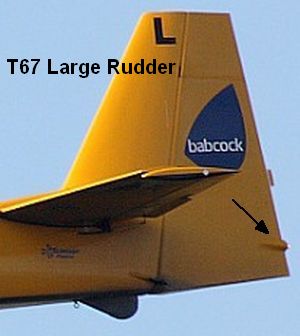
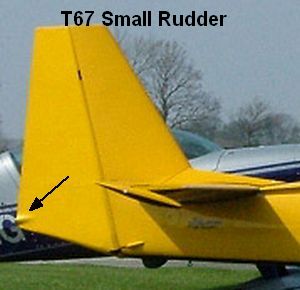

Note how the bottom edge of the T67 "big rudder" (left photo) follows the angle of the bottom of the empennage and so has about three extra inches of rudder below the trailing edge position light. The T67M and T-3A at center and right have a smaller rudder that angles up to the position light.
If we estimate the bottom length of the rudder to be 14 inches that gives us: (14 x 3) / 2 = 21 square inches.Twenty-one square inches of additional rudder that's in the best possible location--mostly at the trailing edge below the elevator in clean air during a spin.
The Problem With The T-3A Firefly
The Air Force had flown the very safe and docile T-41 (Cessna 172F) for over 30 years so it formed the foundation of understanding propeller training aircraft. With the change to the Enhanced Flight Screening Program (EFSP) and an advanced, aggressive flying, fully aerobatic T-3 trainer the demands placed upon the instructor pilot cadre were underestimated.
The original T-3 syllabus had students flying solo out to the training areas. To send students with a total flight time of 16 hours out solo to the areas in a fully aerobatic aircraft without parachutes was completely insane--but that was the plan. Thankfully, just before the first students were scheduled to solo to the training areas, the decision was made to allow students to solo only in the pattern like they did in the T-41. This type of thinking shows how disconnected the creators of the Enhanced Flight Screening Program were from reality.
T-3A instructor pilots never received any "student screws up the spin recovery" training. We got that training on the job and it was eye opening. As mentioned earlier, I had a student fail to remove anti-spin rudder during a spin dive recovery and we snap rolled the opposite direction into a secondary spin. It was very disorienting and I wasn't quite sure what direction I was spinning when I looked up at the horizon. These types of student spin recovery errors should have been presented to instructor candidates during training because the very aggressive nature of the T-3 spin can lead to disorientation, failed recoveries and panic if not prepared. Spins in the T-3A should never have been attempted without parachutes. If we would have had them the first fatal spin crash might have had two survivors.
The Air Force never practiced gliding stalls of any kindbecause they thought of the flight screening program as preparation for the T-37 which has two jet engines and ejection seats so gliding practice is not required. The Air Force got away with not practicing gliding stalls in the T-41 because its stall characteristics were so benign but the T-3's aggressive stall characteristics could lead to a snap roll and spin. Gliding stalls are practiced in the civilian world because once your engine fails and you begin to glide the only way to recover from a stall is to lower the nose--you can't add power to assist in the stall recovery. Lowering an aircraft's nose rapidly during a climbing engine failure needs to be practiced to become second nature. The second and third fatal T-3 accidents were caused by unpowered stalls that progressed into low altitude non-recoverable spins. In contrast, the civilian instructors flying the T-3 with the 3rd Flying Training Squadron at Hondo, Texas were trained in gliding stalls as part of their civilian Certificated Flying Instructor (CFI) training. The military instructor pilots at the Air Force Academy were trained in-house and were not required to hold a CFI.
The problem with the T-3A was twofold. The T-3A was a horrible aircraft to train new students with but the Enhanced Flight Screening Program design was the root cause of the calamity. The Slingsby T67 holds a horrible worldwide safety record but the Enhanced Flight Screening Program developers added aerobatics to flight screening so a fully aerobatic aircraft had to be used. They assumed the T-3A would be as docile and safe as the T-41. The T67/T-3A can be flown somewhat safely but it demands respect, serious preparation and center of gravity limits must be respected. The Air Force instructor pilots were simply not prepared to train zero hour pilots in the T-3A.In my opinion the developers of the Enhanced Flight Screening Program and syllabus didn't prepare the instructor cadre to handle the aggressive, twitchy, demanding, high performance T-3A Firefly. Specifically the stall and spin characteristics of the T-3A were not addressed adequately in the instructor training syllabus. Instructor training should have included "botched student spin recovery training". Gliding stall recovery should have also been included in the instructor and student training syllabi.
The decision to field the T-3A without parachutes proves a wholly inadequate program risk assessment by the developers of the Enhanced Flight Screening Program. The plan to send students with 16 hours of flight time solo out to the practice areas in an aerobatic aircraft without parachutes proves gross negligence with a touch of insanity.
After the T-3A
After leaving the Academy in late '96 I kept in touch with my old squadron's flight safety officers to stay abreast of the T-3 story. When the T-41 was replaced by the T-3 the T-41's were given away to Air Force flight clubs and I was afraid the Air Force might do the same with the T-3. An Academy flight safety officer told me how the Air Force was seriously considering using the T-3 fleet to allow Air Force drone pilots to keep current in a real airplane. At the time a drone pilot had to have at least a Private Pilot's license so the drone drivers felt they should be allowed to actually fly to stay sharp. When I heard the plan I pleaded with the safety officer to do what he could to squash that idea. I told him if they instituted that program they'd have a dead drone pilot on their hands within six months. Maybe someone listened because the Air Force scrapped (pun intended) that idea.
With the T-3 out of commission the Air Force began sending Academy cadets and other potential pilots to civilian instructors to earn a Private Pilot's license before attending AF Pilot Training. This was a fantastic program that gave students more than twice the flight time than what they received in T-3 flight screening, required pattern and cross country solos, night flying and finished up with a real, high pressure FAA check ride. This program also saved a ton of money compared to running two full time squadrons of flight instructors at the Academy and Hondo.
Sometime later the Air Force once again returned to a centralized flight screening program run by Doss Aviation in Pueblo, Colorado using theDiamond DA-20. The program is called Initial Flight Trainingand all potential Air Force pilots and Combat Systems Officers (back seaters) must complete the program before attending their Air Force flight training. The program gives pilot candidates 50 hours of flight time (that's almost three times more flight time than the T-3 program) and CSO's get 20 hours of flight time.
In 2002 the 557th Flying Training Squadron--my old squadron at the Academy--took delivery of the 125 horsepower IO-240 enginedDiamond DA-20 for the Academy's Powered Flight Program. The program exposed cadets to an operational Air Force flying squadron and gave them an opportunity to solo a light, general aviation aircraft. The Powered Flight Program did not replace flight screening as the cadets must still complete the Doss program in Pueblo before attending AF pilot training.
In 2009 the 557th began to fly the T-52A which was derived from the 180 horsepower IO-360 enginedDiamond DA-40. Two years later in 2011 the T-52A was replaced with the 200 horsepower IO-360 engined T-53A derived from theCirrus SR-20. The SR-20 has a large parachute system that can recover the entire aircraft safely back to earth.
US Air Force Cirrus T-53A
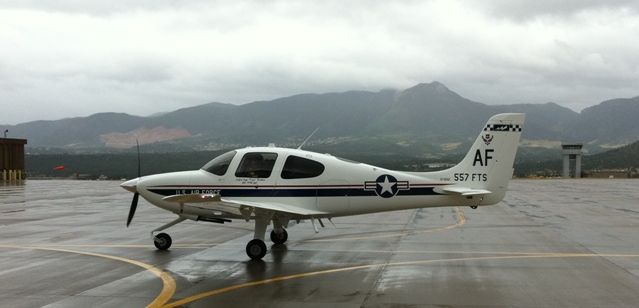
The T-53A was derived from the Cirrus SR-20 and is the current Academy Powered Flight Program trainer. It has a built-in parachute system that is capable of recovering the entire aircraft in an emergency. Shown here on the ramp at the Academy Airfield.
Death of the T-3A
In 2006, nine years after the T-3 fleet was grounded, the Air Force made the decision to scrap the planes because they had severely deteriorated in storage and would have required a crap ton of money to make them airworthy. Not even the expensive IO-540 engine, three blade constant speed propeller system or avionics were pulled from the aircraft--the entire aircraft were chopped up and scrapped. The Air Force actually paid a salvage company to chop them up and haul away the remains.
I think the real reason the aircraft were scrapped was Air Force leadership knew the aircraft weren't safe and they would have continued to kill pilots no matter where they ended up. Four destroyed aircraft and 6 fatalities in less than three years. Yes, all the investigations said "pilot error" but why were so many aircraft lost to "pilot error?" The T-41 flew for 26 years with no fatalities at the Academy. With 36 destroyed T67/T-3A aircraft and 48 fatalities it's pretty clear this airplane has serious problems. That's over 14% of the fleet destroyed in accidents.
In 2010 Slingsby was sold toMarshall Advanced Composites.
Scrapping the T-3A
The Air Force seems to have scrubbed the T-3A from its history. TheAF Academy and557th Flying Training Squadron online histories do not mention the T-3A at all. I had to edit the557FTS wikipedia page to add the T-3A to their list of aircraft flown. Erasing the short history of the T-3A is a disservice to the men that lost their lives in it.
Yes, I know that everyone who survived the T-3 spun it successfully, so did I, but we shouldn't say it's a safe airplane just because we didn't freakin' die in it. Remember, pretty much every pilot killed in the T67/T-3A thought it was safe until just before they hit the ground. With the sorry safety statistics of the T67/T-3A it is one of the most dangerous aircraft to have ever made it to production. The following accident reports prove the spin accidents at the Air Force Academy were no fluke.
My old T-3A DASH-1 Study Guide
By Rob Robinette
T67 Firefly Models
T67A 1981 O-235 4 cylinder 118hp engine, copy of RF-6B, made of wood, 2 blade fixed prop, fuel in firewall tank, single piece canopy, 10 built
T67M 1983 AEIO-320 fuel injected 4 cylinder 160hp engine, 2 blade constant speed prop, fuel in firewall tank, inverted flight systems, single piece canopy, 32 built (32 includes the T67M MKII). Here's a copy of theT67M Instructor Guide
T67B 1984 O-235 4 cylinder 118hp engine, made of glass reinforced plastic as are all models below, 2 blade fixed prop, fuel in firewall tank, single piece canopy, 14 built
T67M MKII 1985 with AEIO-320 fuel injected 4 cylinder 160hp engine, 2 blade constant speed prop, fuel in wing tanks, inverted flight systems, **2 piece canopy.**Here's a copy of theT67M MKII Pilot's Operating Handbook
T67C 1987 with O-320 engine, 2 blade constant speed prop, non-inverted systems, fuel in firewall tank, single piece canopy, 28 built. Some T67C's were built with two piece canopies and wing fuel tanks. The Canadian RAF flew the T67C3 with 2 piece canopies and wing fuel tanks.
T67M200 1987 with AEIO-360-A1E fuel injected 4 cylinder 200hp engine, 3 bladeconstant speed prop, fuel in wing tanks, inverted flight systems, 26 built. This is the aircraft the US Air Force first flew for evaluation.
T67M260 1993 with AEIO-540-D4A5 fuel injected 6 cylinder 260hp engine, 3 blade constant speed prop, fuel in wing tanks, inverted flight systems, both "large" and "small" rudders used, 51 built. This model was developed in less than a year when the US Air Force found the T67M200 inadequate for the high density altitudes of the Air Force Academy Airfield. The AEIO-540 engine was installed in the T67 specifically to meet the requirements of the US Air Force Enhanced Flight Screening Program aircraft.
T67M260-T3A1993 with IO-540-D4A5 fuel injected 6 cylinder 260hp engine, 3 blade constant speed prop, fuel in wings, inverted flight systems, air conditioning, all had "small" rudder, 114 built and sold to the US Air Force. The US Air Force designation was T-3A Firefly. Four were destroyed in accidents, Edwards flight test kept one, the rest were scrapped in 2006.
The total number of T67/T-3A's built is approximately 280.
EASA T67 Certification Document
More T67/T-3A Spin Crash Reports
The Aviation Safety Network hasa list of T67/T-3A accidents that shows 28 destroyed aircraft and 36 fatalities.
ASN T67 Accidents
Notice how many accidents were caused by stalls and spins. The "fat." column means fatalities. The right column "dmg" is damage and "w/o" means the aircraft was "written off" or scrapped. The 8 Aug 95 accident was written off.
The 1998 Enhanced Flight Screening Program Broad Area Review report on page 23 lists eight more fatal T67 crashes not listed in the Aviation Safety Network list shown above. They include:
1984 UK Aerobatics - Aerial display, insufficient altitude for maneuver
1984 UK Cross Country - On training flight, pilot became lost and attempted a bail-out too low
1985 UK Spin - Failed to recover, no pre-impact defects
1987 Sweden Aerobatics - Low level aerobatics
1989 Japan Aerobatics - Steep turn after takeoff, rolled inverted (stall)
1989 Turkey Simulated Forced Landing - Wing dropped near the ground (stall). This is very similar to the Academy's second fatal T-3 accident.
1989 Turkey Formation - On inside of turn after takeoff, hit house
1990 New Zealand Aerobatics - No information
These accidents included 12 fatalities. Adding these eight accidents to the Aviation Safety Network's total of 28 destroyed aircraft and we have a grand total of 36 T67's destroyed with 48 fatalities in flying accidents--that's 14% of the T67 fleet that has been destroyed in accidents.
UK Fatal Stall or Spin Accident Summary (1980-2008) report:
"The accident rate for the Slingsby T67 was throughout the period much greater than any other certified type and has been treated as a special case. . . The Slingsby T67, (8 fatal accidents) was excluded from the main numerical analysis but was studied as a special case. . . Apart from the Slingsby T67, no significant problem has been revealed in spin recovery."
In other words the T67 has a significant spin recovery problem.
Review of UK General Aviation Fatal Accidents 1985-1994
Only one other aircraft has more fatal accidents per 100k hours.
York England T67M MKII Spin Crash 2016
Two RAF student pilots killed in light aircraft crash named by police
EveningStandard by LAURA PROTO
Monday 2 May 2016
[stock photo of Slingsby Firefly]
Crash: The pair were reportedly flying in a Slingsby Firefly
Two “exceptionally talented” RAF student pilots who died after their plane crashed into a remote field in Yorkshire [UK] have been named by police.
The light aircraft they were travelling in crashed in fields between Castle Howard and the A64 north of York on Saturday.
North Yorkshire Police today named the victims as 25-year-old Ajvir Singh Sandhu from Essex and Cameron James Forster, 21, from Sussex.
Both men were student pilots in the RAF.
Group Captain Ian Laing, station commander at Royal Air Force Linton-on-Ouse, said: "We were very saddened to hear of the deaths of Aj Sandhu and Cam Forster in a civilian flying accident at the weekend.
“They were both exceptionally talented young men in the prime of their lives. The thoughts of everyone at RAF Linton-on-Ouse are with their family and friends at this difficult time”.
Police said they received multiple calls from members of the public at about 10.40am on Saturday after the aircraft came down.
The Air Accidents Investigation Branch (AAIB) are continuing to probe the cause of the crash.
Speaking at the scene on Saturday, Superintendent Mark Grange, of North Yorkshire Police, said the plane landed more than 200m away from the nearest houses and looked like it had come “straight down”.
He added: “[The aircraft is] in a bad way and it's obviously come down heavily. It's sat on its underside so it has not flipped.
“Whether they tried to land like that I don't know.
“I cannot say where they were going and what they were doing in the air.”
[Rob adds: The description and pictures of the crash site strongly suggest this is another spin-to-impact accident. The two pilots were members of the Royal Air Force but they rented the civilian Firefly for personal use and "a bit of aerobatics," which may have included intentional spins.]
T67M MKII Crash Site Near York, England

Looks a lot like the US Air Force T-3A spin crash sites with the aircraft mostly intact and delaminated wings. The engine is buried in the dirt just in front of the aircraft. The angle of the engine and position of the wings and tail strongly suggest the aircraft hit the ground in a stabilized left-hand spin. Note this T67M MKII has a small rudder. Photo by the UK Mirror_._
Jordanian Air Force T67M260 Crash 2015
The aircraft crashed during a training mission. The instructor and student were both killed.
Crash site is typical of a spin impact & fire.
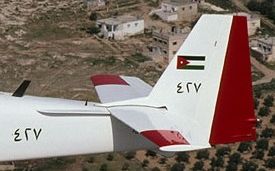
The Jordanian T67M260's had the big rudder.
Mojave AirportNational Test Pilot School T67M260 Spin Crash 2014
NTSB Identification: WPR15FA021
14 CFR Part 91: General Aviation
Accident occurred Friday, October 24, 2014 in Ridgecrest, CA
Aircraft: SLINGSBY T67M 260, registration: N456FR
Injuries: 2 Fatal.
This is preliminary information, subject to change, and may contain errors. Any errors in this report will be corrected when the final report has been completed. NTSB investigators either traveled in support of this investigation or conducted a significant amount of investigative work without any travel, and used data obtained from various sources to prepare this aircraft accident report.
On October 24, 2014, about 0900 Pacific daylight time, a Slingsby T67M-260, N456FR, was substantially damaged when it impacted terrain near Ridgecrest, California. The airplane was registered to L'Avion Inc., Mojave, California, and operated by the National Test Pilot School under the provisions of Title 14 Code of Federal Regulations Part 91. The flight instructor and passenger were fatally injured. Visual meteorological conditions prevailed and no flight plan was filed for the instructional flight. The local flight originated from Mojave Airport (MHV), Mojave, about 0832.
Information provided by representatives from the National Test Pilot School revealed that the flight was part of the Flight Test Engineer training program and that the flight had the primary focus of spin training. Following a loss of radar and radio contact with Air Traffic Control, the wreckage was located by company aircraft.
Examination of the accident site revealed that the airplane impacted open desert terrain about 12 miles south of Ridgecrest. Wreckage debris remained within about 10 feet of the main wreckage. Vegetation, about 12 to 18 inches in height, located immediately to the left and right of the aft area of the fuselage appeared to be undamaged. All major structural components were located at the accident site. [Rob adds: the crash sight is typical of impact in a stabilized spin] The wreckage was recovered to a secure location for further examination.
The Director of Business Operations at the National Test Pilot School at the Mojave Air and Space Port, was one of two men who died Friday morning in the fatal crash of a T-67 Firefly aerobatic plane during a training flight northwest of Randsburg.
Michael Hill, 68, of San Diego and Ilam Zigante, 27, of Lancaster died in the crash of the two-seat, single engine plane, according to the Kern County Sheriff's office coroner's division. Hill was a director and instructor at the school, where flyers are trained as test pilots for propeller-powered airplanes, jets and helicopters, according to the non-profit company's website. The other person in the plane — Zigante — was a student according to Kern County Fire Department spokesman Martin Hernandez said.
The National Test Pilot School referred callers to a press release about the crash which identified the plane and the circumstances of the crash but did not name Hill or Zigante.
The single-engine, two-seat aircraft crashed about three miles northwest of Randsburg, about 20 miles from Ridgecrest, at 10:13 a.m. Friday. More specifically, the plane went down about one mile north of Redrock Randsburg Road, near Garlock Road.
The cause of the crash had also not been determined. The plane did not catch fire. Rescue crews were called in after air traffic control lost contact with the private plane, Hernandez said. Kern County sheriff's Lt. Tom Little said he did not know where the plane was coming from and where it was going. Initially, the area's mountainous terrain made it difficult for Kern County deputies to reach the scene by vehicle and for the rescue air unit to land. The scene of the accident was cleared at around 1 p.m.
The National Transportation Safety Board and Federal Aviation Administration will investigate the crash.
[Rob adds:The instructor pilot in this aircraft was a professional test pilot instructor so even the best pilots can have problems with the T67's spin and recovery characteristics.]
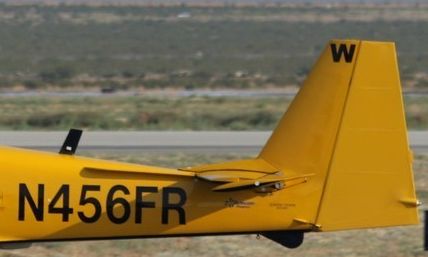
The accident aircraft had a big rudder.
Turkish Air Force T67M200 Spin Crash 2011
Instructor and student were killed during a training flight. Eyewitness testimony described a vertical spin to impact. The crash site is also typical of a spin impact.

The accident aircraft had a small rudder.
Jordanian Air Force T67M260 Firefly Spin Crash 2009
A Jordanian AF T67 Firefly crashed due to an unrecoverable spin in June 2009. The student successfully bailed out but the instructor pilot died in the crash. The Jordanian AF lost two other T67M260's to accident previous to this mishap.

The Jordanian T67M260's had the big rudder.
Hoxne UK T67M MKII Aerobatic to Inadvertent Spin Crash 2006
The pilot was performing a solo aerobatics sequence, in good weather. The aircraft appeared to depart from controlled flight at a height of around 4,500 ft agl during a looping manoeuvre and settled into an erect spin to the left. After the aircraft had descended about 2,500 ft, the pilot transmitted a ‘Mayday’ call in which he said that he was in a spin and could not recover. The aircraft continued to spin and descend vertically until it struck the ground. The pilot was fatally injured in the impact.
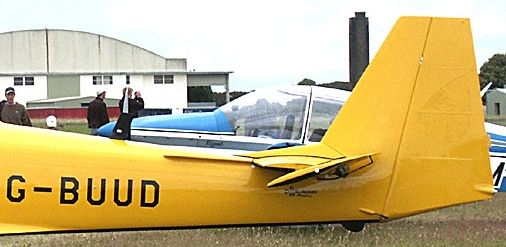
The accident aircraft had a small rudder.
Potterspury UK T67C Spin Crash 2005
Training flight to include practice spins. Eyewitness saw aircraft enter a spin and spin all the way to impact. Instructor and student were killed.
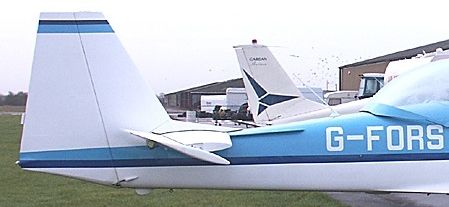
The accident aircraft had a small rudder.
Banbury UK T67B Spin Ride Crash 2002
The two pilots had briefed for a spinning detail as part of a Flying Instructor's course at Oxford (Kidlington) Aerodrome. Some 24 minutes after departure, witnesses saw the aircraft descending in a spinning manoeuvre just to the west of Banbury England. The aircraft continued this manoeuvre until going out of sight. It impacted the ground in an erect attitude, at a high vertical rate of descent and with almost no rotational movement. Neither pilot was wearing a parachute and both were fatally injured on impact. [This aircraft most likely had a small rudder.]
Harriseahead UK T67C Spin Related Crash 1998
"Both persons on board were killed. According to the AAIB report, the accident seems to have been due to the aircraftfailing to gain sufficient altitude recovering from a spin whilst conducting spinning recovery practice over high ground." [Rob adds: In other words it took much longer to recover from the spin than the pilot thought it would. This aircraft most likely had a small rudder.]
Old Warden Airfield UK T67M200 Airshow Firefly Spin Related Crash 1996
4 May 1996 The aircraft pulled up and performed a vertical half roll, followed by a negative cap lomcovak manoeuvre. This was followed by a spin to the left. The planned sequence was to stop the spin and execute a negative 'g' push-out to the horizontal, then to perform a two point hesitation roll to become erect. However, on recovering from the spin there was insufficient height available to complete the push-out manoeuvre and the aircraft flew inverted into trees to the east of the display line, on the opposite side of the runway and away from the crowd. The pilot was killed in the crash. [Rob adds: Again, in other words it took much longer to recover from the spin than the pilot thought it would. This aircraft most likely had a small rudder.]
Waddesdon UK T67C Spin Crash 1988
". . . failed to recover from a spin and dived into the ground near the A41 road, 2 km east of Waddesdon, near Aylesbury, Buckinghamshire, killing the two persons on board (instructor and pilot under training)." [This aircraft most likely had a small rudder.]
Effingham UK T67A Engine Failure - Spin Crash 1987
At the top of a loop the engine failed and the aircraft entered a spin and crashed. Both occupants were killed. [This aircraft most likely had a small rudder.]
Switzerland 1987 Spin Crash
From theEnhanced Flight Screening Program Broad Area Review report page 23:
"Spun too low to ground--no defects noted" Two fatalities. [Rob adds: Again, in other words it took much longer to recover from the spin than the pilot thought it would]
Cranfield UK T67M Stall-Spin Crash 1986
5th of May 1986, it was at the Barnstormers May Day Display. I stood and watched it happen, [the T67] spun in off a low tight turn. I was standing with other members of the Barnstormers at the time, we all began to run to the scene but I was turned away by Murry Felstead before I witnessed what he had seen. Not a pretty site by all accounts. I believe the pilot's name was Paul Bishop, his girl friend was in the crowd at the time.
[Rob adds: If you pull too hard and get some stall buffet along with a little rudder displacement a snap roll (flick) can happen very quickly.]
UK 1985 Spin Crash
From theEnhanced Flight Screening Program Broad Area Review report page 23:
"Failed to recover [from a spin], no pre-impact defects" Two fatalities.
Found on anonline aviation forum archive:
Karl Bamforth
5th Jun 2009, 06:24
I remember an instructor and student getting into trouble trying to recover from a spin in a T67 in the UK. Its a few years ago but when the Instructor told me what happened I could see how a student could get themselves into serious trouble. Thankfully both student and instructor survived the incident.
To the best of my fragile memory:
The instructor demonstrated a spin and recovery with no problems.
Handed control to student, the spin and recovery was normal until the "pull out from ensuing dive" part, they started to pull out of the dive but suddenly and violently departed and flicked hard into another spin.
The instructor took control and initiated recovery, once again the recovery was normal but in the later stages the aircraft once again flicked into another spin.
The instructor thought the problem was they were pulling too hard during the recovery causing the pitch angle to increase rapidly causing a further stall spin. On the last attempt he was much gentler in the recovery from the dive. The aircraft recovered normally.
Now if this had been a low hour pilot watching the ground getting ever closer and with a certain amount of panic setting in I think it would have ended in disaster.
Its the only first hand account I have come across and it seems to fit the other failure to recover stories I have heard. It certainly cured me of wanting to spin a T67.
[Rob adds: Because the T67/T-3A spins so nose low the spin recovery dive is very steep and it is common to pull the elevator too hard and get a secondary stall or buffet during the dive recovery. As I mentioned earlier, if there is ANY rudder displacement during a stall or buffet the T67/T-3A will snap roll (flick) into a spin. If the rudder was rigged so the rudder was NOT neutral when the rudder pedals were neutral then it would be easy to encounter the behavior described in this post. Also, in the heat of the moment during the dive recovery it is easy to forget to neutralize the rudder or simply misalign your feet and leave enough rudder displacement to cause a snap roll spin.]
References
The Making of a Trainer, The Air Force's acquisition of the hapless Slingsby T3-A, Light Plane Maintenance magazine, February 1998
Vapor Lock by Design, Light Plane Maintenance magazine, November 1997 (Describes the T-3A's defective fuel system design)
Flight Test Slingsby Firefly, Flyer magazine, December 2011
The Deadly Trainer, CNN.com
In 2010 Slingsby was sold toMarshall Advanced Composites
Have additional information or a correction? Pleaseemail Rob at robinette at comcast dot net
Check out Rob's short story about a fighter engagement over the skies of Iran, The Engagement
About the author: Major Rob Robinette began his flying career just after high school in the US Army. He graduated from Aviator training as a Warrant Officer 1 in February '79 and flew his first assignment as a UH-1H Huey pilot with the 2nd Infantry Division in northern South Korea. He became an aircraft commander while in Korea at age 20. Upon return from Korea he was assigned to the 2nd Armored Division at Fort Hood, Texas. He soon transitioned to the OH-58A Kiowa (Bell Jet Ranger). In 1981 he became a pilot member of theWorld Champion United States Helicopter Teamwhich competed in Poland against teams from the Soviet Union, Poland, East and West Germany, France and Britain. The team won the individual and team world championship. Chief Warrant Officer 2 Robinette separated from the Army in January '82 and attended college and Air Force ROTC at the University at Texas at Austin. Second Lieutenant Robinette graduated and was commissioned in May of '85. He attended Air Force Euro NATO Joint Jet Pilot Training at Sheppard AFB, Texas. His first assignment after graduation was an F-15 Eagle to Holloman AFB, New Mexico. Rob also flew two tours in the C-141 Starlifter in addition to his four year tour at the Air Force Academy. He attended the Air Force Flight Safety Officer Course in 1995. In May '96 he earned an MBA in Finance from the University of Colorado. After retiring from the Air Force in 2002 he flew for Southwest Airlines and retired in 2023. Rob also holds an FAA Powerplant Mechanic and CFII (Certificated Flight Instructor Instrument) rating.
